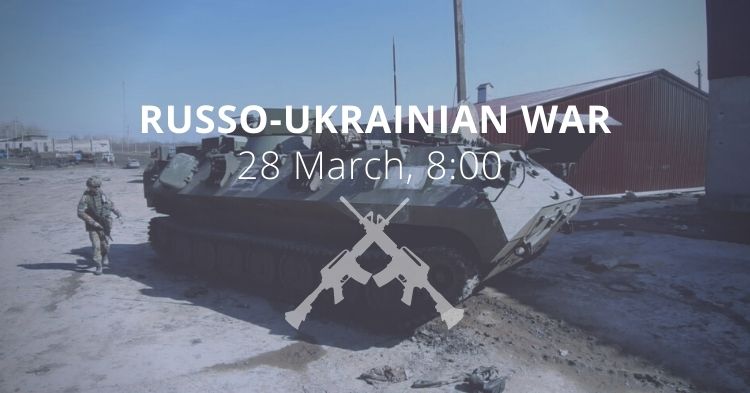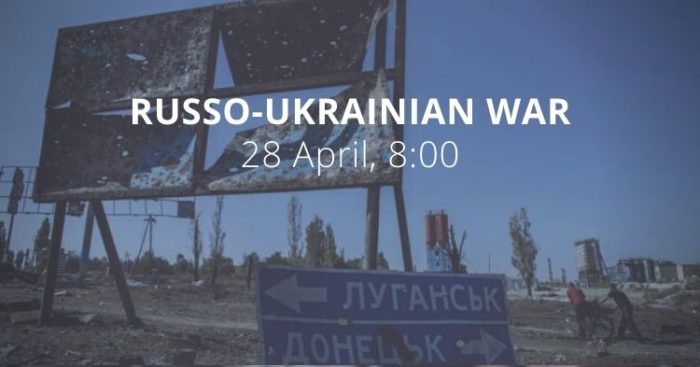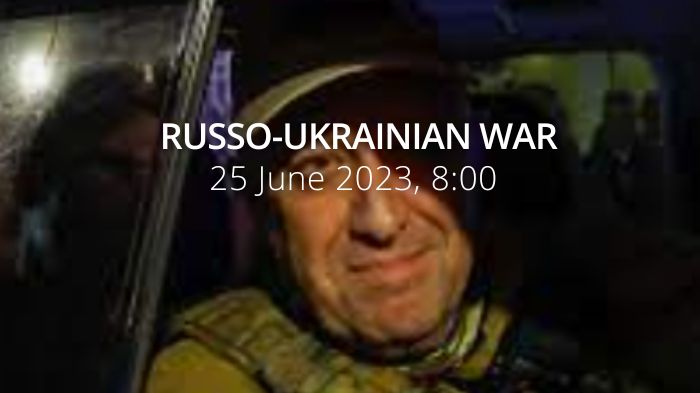Morning report day 33 - March 28
The report is based on media reports, expert analyses, and official information posted online.
Situation
According to information from the General Staff as of 06.00 28.03.2022, supplemented by its [midnight assessment]:
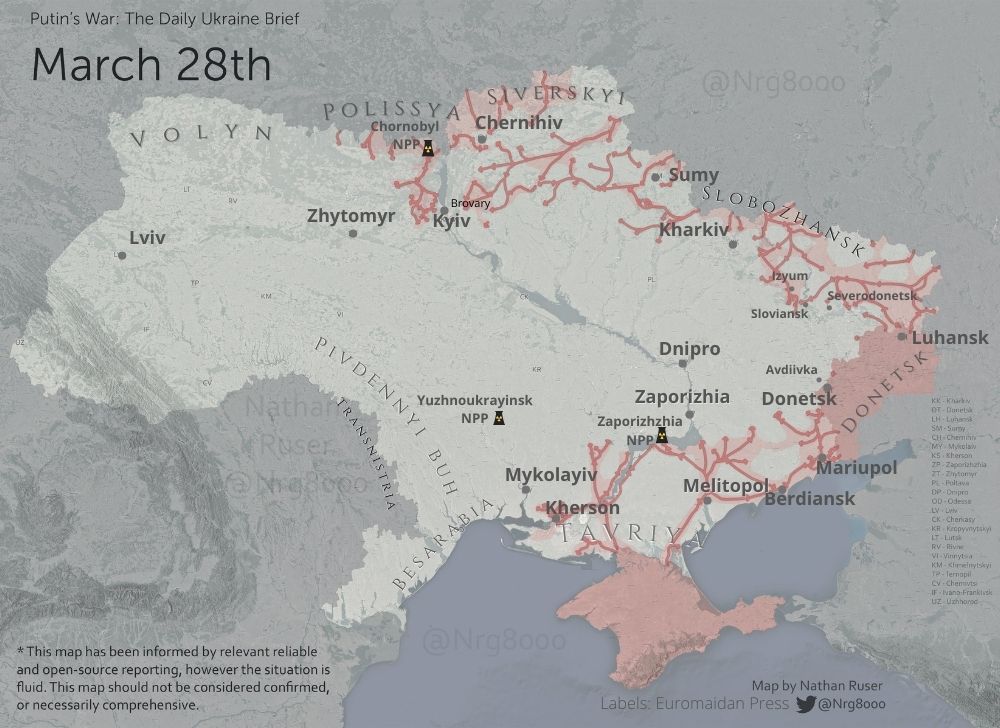
[The Russian occupiers continue to launch missile and air strikes on important military infrastructure and first-line positions to inflict losses and deplete personnel.]
[The Russian enemy did not carry out active offensive operations in the Polissya direction. The regrouping of individual units from the Eastern Military District continues. Units that have suffered significant losses in the course of offensive operations are usually deployed to Belarus to restore combat capability. Thus, the withdrawal of up to 2 Battalion Tactical Groups (BTG) from the 106th Airborne Division from the Kyivov oblast to the territory of the Republic of Belarus is noted.]
- The grouping of Ukrainian forces and means of defense of the city of Kyiv is deterring the Russian enemy, which is trying to break through the Ukrainian defense from the Northwest and East to take control of key roads and settlements.
In the Volyn and Siversky directions, there is the conduction of defense operations and other tasks in certain operational areas continue. The situation is under control and has not changed significantly.
[In the Volyn direction there is a high probability of involvement of the armed forces of the Republic of Belarus in the aggression against Ukraine. Air reconnaissance continues in the areas of Kovel, Varash, Sarny. Transportation of rockets to the "Iskander" (9K720 Iskander (SS-26 Stone) - a mobile short-range ballistic missile system by the transportation road to the area of the settlement of Kalinkovichi is recorded.]
[The Russian enemy did not carry out offensive operations in the Siversky direction. It focused its efforts on consolidating and maintaining the previously occupied borders.]
[In the Slobozhansky direction, the enemy abandoned the offensive near the city of Sumy, trying to regroup and withdraw units to other directions. Thus, one of the BTGs from the 1st Tank Army of the Russian enemy, which was involved in hostilities, was fully withdrawn from Ukraine to the territory of the Russian Federation.]
- [The occupiers continued to strike at infrastructure facilities in Kharkiv. In the direction of the city of Izium, the Russian enemy tried to conduct offensive operations.]
In the Donetsk and Luhansk directions, the Ukrainian Joint Forces repulsed 5 Russian attacks per day. Ukrainian soldiers destroyed 2 tanks, an infantry fighting vehicle, and one vehicle. The Russian enemy also suffered casualties. The data on quantity is specified.
First captured Russian tanks T-72B3&T-90 are joining the Ukrainian army after repairs & training for soldiers.
"We strengthened the guys with tablets, software; communication devices are coming to the unit," volunteers of Povernys Zhyvym fund reported.https://t.co/oX3GBJjIJQ pic.twitter.com/PDOMy9TCCE
— Euromaidan Press (@EuromaidanPress) March 27, 2022
- In the Avdiivka direction, Ukrainian warriors repel the assaults of the Russian occupiers in the area of the settlement of Verkhnotoretske.
- [In the Donetsk direction, the enemy focused its efforts on taking control of the settlements of Popasna, Rubizhne, and entering the Novotroitsky district, as well as capturing the city of Mariupol, but without success.]
- [The enemy carried out artillery and mortar shelling of the settlements of Toretske, Svitlodarsk, Troitskoye, and Pisky.]
- [The main goal of the occupiers remains to reach the administrative borders of the Donetsk and Luhansk regions.]
[In the Tavriya direction, the Russian National Guard units continue to carry out filtration measures in the temporarily occupied territories in the Kherson Oblast.]
- In the south, the main efforts of the Ukrainian Defence Forces are focused on the organization of defense activities in the cities of Kryvyi Rih, Zaporizhzhia, and Mykolayiv, to maintain certain areas of the seacoast, protection and defense of critical infrastructure. Stabilization operations and territorial defense tasks are underway in certain areas.
- The grouping of Ukrainian troops effectively restrains the advance of the Russian enemy in the directions of the settlements of Huliaipole and Zaporizhzhia.
[In the Pivdennyi Buh directions, the enemy's position and actions remained unchanged.]
[The Armed Forces of Ukraine continue to inflict significant losses on the Russian enemy. According to available information, over the past five days, about 600 bodies of servicemen killed in Ukraine have been brought to the military garrisons of the Nizhny Novgorod region, most of whom served in the 47th Tank Division of the 1st Tank Army
of the Western Military District.]
The Air Force of the Armed Forces of Ukraine destroyed 4 planes, 1 helicopter, 2 UAVs and 2 cruise missiles in the previous day. The Air Force was also involved in striking certain ground targets and occupiers.
[The Russian enemy continues to move additional units from the Pacific Fleet and the Western Military District in order to continue the full-scale armed aggression against Ukraine. At the same time, there is a significant decrease in the intensity of moving from the depths of the Russian Federation.]”
Armed Forces of Ukraine destroyed a Russian convoy and seized two almost new two Russian Ural Tornado-U heavy utility trucks with ammunition, two "Tigers", and a tank in the Sivershchyna direction, Operational Command North claims.
The Ukrainian Armed Forces (UAF) liberated the village of Husarivka (Kharkiv Oblast) on Sunday 27 March, the Center for Strategic Communications and Information Security (SPRAVDI) reports. Husarivka was occupied by 2 BTGs of the Russian occupiers with the support of Russian special forces. It is reported that UAF destroyed about 60 units of enemy equipment, personnel losses are being clarified, but the score is "a hundred". In the Kharkiv region, the UAF liberated several settlements in the direction of Mala Rohan on Saturday, Ukrainska Pravda reports.
https://twitter.com/EuromaidanPress/status/1508081365400576005
The Russian forces can’t solve the problems with field repairs of damaged weapons and military equipment, the Ukrainian Defence Intelligence reports. Russian military leadership is trying to replenish these losses with the equipment removed from long-term storage. At the airfield in the village of Klimove, Bryansk region (35 km from the border of Ukraine), Russia is deploying a repair and rehabilitation base (RVB) that is trying to "put into operation" both equipment coming from long-term storage facilities, as well as equipment that has been damaged on the battlefield. Russia often finds it close to impossible to restore equipment coming out of "conservation".
Optical devices and electronics containing precious metals were completely stolen from the combat vehicles. In particular, the 4th Tank Division found that only one out of ten conserved tanks are in a more or less operational condition. The rest are completely dismantled. Some of them do not even have engines. At present, plans to transfer equipment taken from storage to the front have been thwarted.
Russia has started destroying Ukrainian fuel and food storage depots, Reuters reports. This means the government will have to disperse the stocks of both shortly, Ukrainian Interior Ministry adviser Vadym Denysenko said on Sunday.
According to British Defence Intelligence, (last 24 hours):
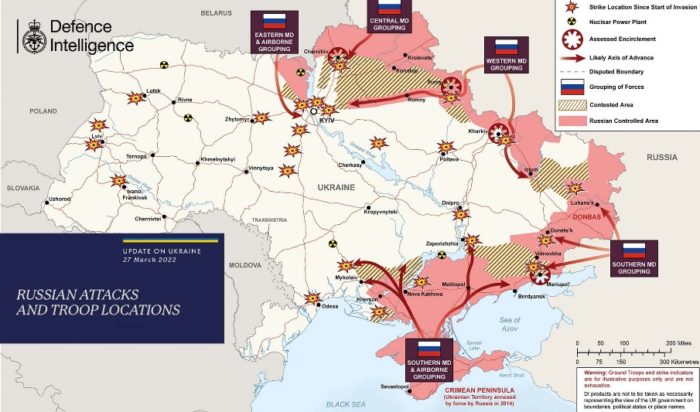
- In the last 24 hours, there has been no significant change to Russian Forces dispositions in occupied Ukraine.
- Ongoing logistical shortages have been [deepened] by a continued lack of momentum and morale amongst the Russian military, and aggressive fighting by the Ukrainians.
- Russia has gained most ground in the south in the vicinity of Mariupol where heavy fighting continues as Russia attempts to capture the port.
- Russia is maintaining a distant blockade of Ukraine’s Black Sea coast, effectively isolating Ukraine from international maritime trade.
- Russian naval forces are also continuing to conduct sporadic missile strikes against targets throughout Ukraine.
- The destruction of the Saratov landing ship at Berdiansk will likely damage the confidence of the Russian Navy to conduct operations in close proximity to the coast of Ukraine in the future.
- Russian forces appear to be concentrating their effort to attempt the encirclement of Ukrainian forces directly facing the separatist regions in the east of the country, advancing from the direction of Kharkiv in the north and Mariupol in the south.
- The battlefield across northern Ukraine remains largely static with local Ukrainian counterattacks hampering Russian attempts to reorganize their forces.
As of Monday 28.03.2022, the approximate losses of weapons and military equipment of the Russian Armed Forces from the beginning of the war to the present day:
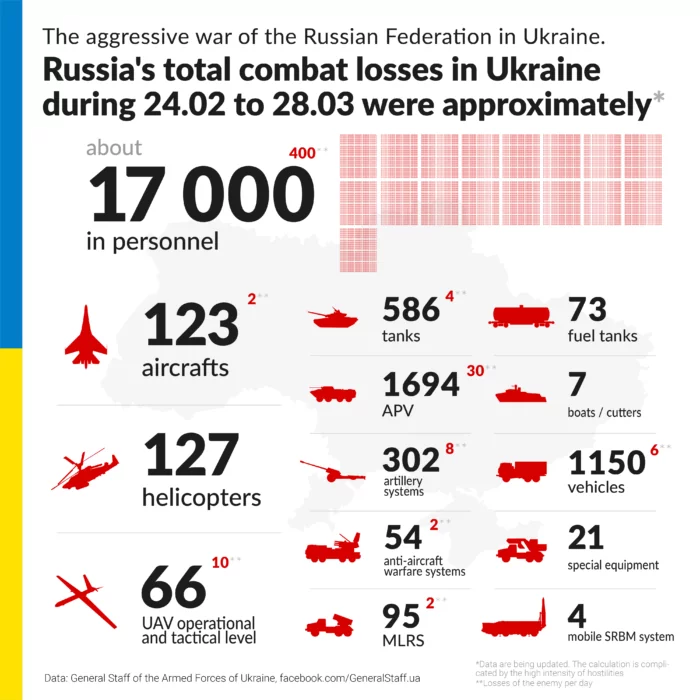
- personnel – more than 17,000 people (+400),
- tanks – 586 units (+4),
- armoured combat vehicles – 1694 units (+30),
- artillery systems – 302 (+8),
- multiple rocket launchers – 95 (+2)
- air defence means – 54 (+2),
- aircraft - 123 (+2),
- helicopters - 127 (no change),
- automotive technology – 1150 (+6),
- vessels/boats - 7 units (no change),
- fuel and lubricant tanks – 73 (no change),
- UAV operational and tactical level – 66 (+10)
- Special equipment – 21 (no change)
- Mobile SRBM system – 4 (no change)
Humanitarian
According to UNHCR 3,821,049 refugees have been registered as of 26 March. The UN says that so far Poland has taken in 2,267,103 refugees, Romania 586,942, Moldova 381,395, Hungary 349,107, Russia 272,012, Slovakia 271,254 and Belarus 6,341.
How the Lviv train station welcomes Ukrainian refugees fleeing Russia’s war | Photo report
As of midnight on 26 March OHCHR has recorded 2,909 civilian casualties in the country: 1,119 killed (99 children), and 1,790 injured (126 children). In contrast, the Office of the Prosecutor General of Ukraine reports 139 children were killed and more than 205 children were injured. It is still impossible to establish the actual number of dead and wounded due to the ongoing combat operations happening in Ukrainian cities.
Both agreed humanitarian corridors on March 27 worked to enable the evacuation of 1,000 civilians from Donetsk (including routes from Mariupol), and Luhansk Oblasts, Deputy Prime Minister - Minister of Reintegration of Temporarily Occupied Territories of Ukraine reported
Environmental
Ministry of Environmental Protection and Natural Resources of Ukraine reports that Russian forces are destroying the ecosystems of the Chornobyl Exclusion zone: 10,111 hectares have been destroyed by fire as of March 26, 2022. As a result of hostilities, the level of radioactive air pollution is increasing.
NSI “Neutron Source” is a nuclear subcritical installation situated in the National Science Center of Kharkiv Institute of Physics and Technology. The following damages to the NSI “Neutron Source” resulting from the site shelling by Russian troops on 26 March 2022 have been identified: (1) significant damage to the thermal insulation lining of the NSI “Neutron Source” building, and (2) partial shedding of lining materials in the experimental hall of the installation.
In the report “Tapering in time of conflict” the UN Conference on Trade and Development (UNCTAD) highlight that:
“The global economy is, literally and metaphorically, staring down the barrel of a gun. Stopping the war in Ukraine, rebuilding its economy and delivering a lasting peace settlement must be the priorities. But the international community will also need to deal with the widespread economic damage that the conflict is already causing in many parts of the developing world; damage that will only intensify as the conflict persists. Recalling George Marshall’s response to the challenges of an earlier post-conflict world, the truth of the matter is that for a significant number of countries, the financial requirements for the next few years are so much greater than their present ability to pay that substantial additional help will be needed to mitigate economic, social, and political deterioration of a very grave character.
Europe will be harder hit by both high commodities prices and the conflict in Ukraine. Across Europe, higher food and fuel prices will constrain domestic expenditure, weakening aggregate demand. Eastern European and Central Asian economies too will be hit hard by the conflict. Higher food prices, falling remittances and large numbers of refugees will place these economies under strain
. The picture for the region as a whole is mixed, with some economies directly or indirectly suffering severe losses from the conflict and trade restrictions (induced by sanctions or by the inability to reach exporting hubs), and others being able to gain market access and at higher prices.
Economies of Africa will be affected in mixed ways, but growth expectations for 2022 of the region as a whole will be lower than estimated earlier in the year. The considerable weight of oil and gas exports of the region will stimulate growth through higher volume and prices, but commodities represent a mixed bag. Only few of the staples exported by Africa are likely to help circumvent the bottlenecks resulting from the conflict in Ukraine, but for the most part African economies are either food dependent or face supply bottlenecks of their own.”
Legal
The Russian Federation is performing mass deportation of the population of the occupied territories of Ukraine. The Russian Ministry of Defense reports that 90,000 citizens of Ukraine, Moldova and Russia have already been deported from the Kherson region. The Russians claim that the grounds for relocation are "appeals of embassies and applications submitted to the military commandant's office of Kherson".
Over the past day alone, more than 19.6 thousand civilians, including 3,300 children, were deported from the temporarily occupied territories of Ukraine in Donetsk and Luhansk regions. This was announced by the head of the Russian National Center for Defense Management, Colonel-General Mikhail Mizintsev. In total, Mizintsev notes the evacuation of 439,420 civilians "from dangerous areas of Ukraine", of which 91,673 are children, and 98,081 people were displaced from Mariupol "due to nationalist arbitrariness", including 4,183 people over the past 24 hours. The scale of the forced relocation is comparable only to deportation performed by Nazis during World War II.
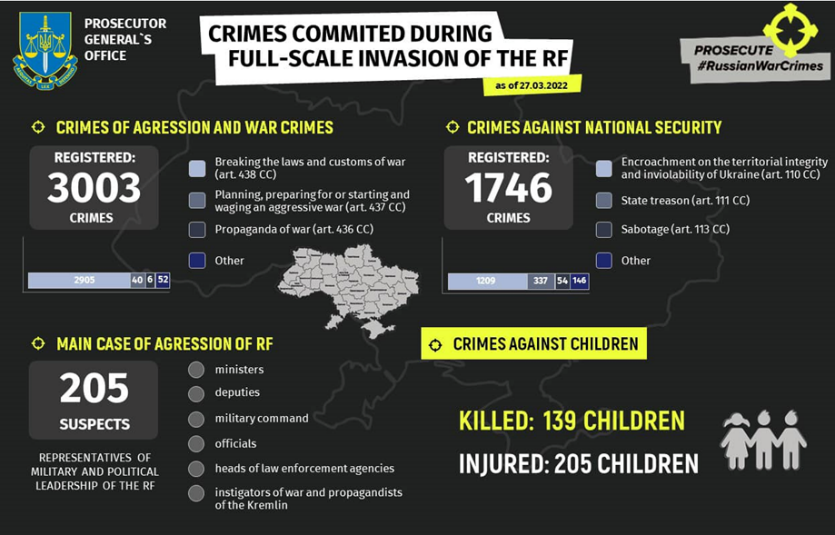 Overall registered numbers of crimes: 3003 crimes of aggression and war crimes, and 1746 crimes against national security.
Overall registered numbers of crimes: 3003 crimes of aggression and war crimes, and 1746 crimes against national security.
The Ukrainian Defence Intelligence has obtained a list of the military personnel of the battalion tactical group of the 155th separate brigade of the marines (unit 30926). It is normally deployed in Vladivostok and the village of Slavyanka, Primorsky Krai. It is presently engaged in the invasion of Ukraine.
Human rights initiatives draw attention to kidnapped activists. The human rights initiative Euromaidan SOS has published a list of 36 civic activists who were persecuted after the invasion. Among them are local mayors and deputies, volunteers, and priests. President Zelenskyy told in an interview with The Economist that some mayors kidnapped by Russia are no longer alive. Zmina human rights organization has launched the campaign #TheTaken, calling to draw attention to kidnapped civic activists.
Russia has persecuted 36 local gvt officials, journalists, religious leaders, volunteers & civic activists on territories it occupied in Ukraine - @sosmaydan
Persecution = physical violence, kidnapping, arbitrary detentions, threats https://t.co/8k1H9NaTKm
— Euromaidan Press (@EuromaidanPress) March 28, 2022
.@zminaUA launches campaign #TheTaken to draw attention to >30 Ukrainian journalists, gvt officials & activists Russia kidnapped during war
"Russia aims to terrorise the people of Ukraine into submission. They must not be allowed to continue" https://t.co/2wTdYDjxAd pic.twitter.com/zBLH35Fzre
— Euromaidan Press (@EuromaidanPress) March 28, 2022
Support
The Hungarian Prime Minister Viktor Orban has sought to assert Hungary's neutrality in the war in Ukraine, even as his allies in the EU and NATO assist the embattled country and punish Russia for launching the largest armed conflict in Europe since World War II, ABC News reports. Orban, who faces a difficult election on April 3, has refused to supply Ukraine with military aid — alone among Ukraine's EU neighbors — and has not allowed lethal weapons to be shipped to Ukraine across Hungary's borders. Orban reject Zelenskyy's appeal, saying Friday that
“the Ukrainian president's requests were against Hungary’s interests. He claimed that sanctions on Russian energy would mean that the Hungarian economy would slow down and then stop within moments. Blocking Russian energy exports would force Hungarians to pay the price of the war, Orban said, noting that 85% of Hungary’s gas and more than 60% of its oil comes from Russia.”
New developments
1. Negotiations are still ongoing. In an interview with the Russian outlet Meduza Sunday 27 March, President Zelensky said:
- "Denazification and demilitarization" - we do not discuss this at all. We will not sit at the table at all if we talk about "demilitarization" and "denazification". These are completely incomprehensible things.
- He offers a "mirror agreement" on respect for history, language, and values based on the principle of reciprocity: you open for us, we open for you. “I want to sign such an agreement with all neighboring countries - Russia, Hungary, Poland, Romania and so on."
- Ukraine is ready to have a neutral status: "(...) security guarantees and neutrality, the nuclear-free status of our state. We are ready to go for it. This is the most important point." To establish a neutral status in Ukraine, there will, however, be a referendum in which refugees will be able to vote.
- Zelensky suggests returning to the situation before February 24: "I understand that forcing Russia to completely liberate the territory is impossible, it will lead to World War III. This is a compromise. Go back to where it all started, and we will try to solve the Donbas issue [later]."
More details in our twitter thread.
https://twitter.com/EuromaidanPress/status/1508366588398948355
Roskomnadzor, Russia’s Federal Service for Supervision of Communications, Information Technology, and Mass Media responsible for monitoring, controlling, and censoring Russian mass media, has demanded that all Russian media refrain from publishing interviews with President Zelenskyy, Ukrainska Pravda reports.
2. The US has no strategy for regime change in Russia, Reuters reports. The United States has no strategy of regime change for Russia, Secretary of State Antony Blinken told reporters on Sunday after President Joe Biden said Russian President Vladimir Putin "cannot remain in power".
"I think the president, the White House, made the point last night that, quite simply, President Putin cannot be empowered to wage war or engage in aggression against Ukraine or anyone else," Blinken said.
3. Achieving first a ceasefire and then the total withdrawal of Russian troops by diplomatic means, is according to President Macron, his task, France24 reports citing the broadcaster France 3.
4. The UK says Russian sanctions could be lifted with Ukraine withdrawal, Reuters reports. British foreign minister Liz Truss says sanctions imposed on Russian individuals and companies could be lifted if Russia withdraws from Ukraine and commits to ending aggression, the Telegraph newspaper reported on Saturday.
"Those sanctions should only come off with a full ceasefire and withdrawal, but also commitments that there will be no further aggression. And also, there’s the opportunity to have snapback sanctions if there is further aggression in future. That is a real lever that I think can be used."
Assessment
1. On the War
The Institute for the Study of War has made the following assessment as of Sunday 27 March:
Ongoing Russian efforts to replace combat losses in EMD units and deploy additional reinforcements forward are unlikely to enable Russia to successfully resume major operations around Kyiv in the near future. The increasingly static nature of the fighting around Kyiv reflects the incapacity of Russian forces rather than any shift in Russian objectives or efforts at this time.
Ukrainian forces continued to conduct limited counterattacks in several locations, recapturing territory east of Kyiv, in Sumy Oblast, and around Kharkiv in the past 24 hours. Ukrainian counterattacks are likely enabling Ukrainian forces to recapture key terrain and disrupt Russian efforts to resume major offensive operations. Likely escalating Ukrainian partisan operations around Kherson are additionally tying down Russian forces. Russian forces continue to make slow but steady progress in Mariupol, but Russian assaults largely failed elsewhere in the past 24 hours.
Key Takeaways
- Russian Eastern Military District (EMD) Commander Colonel-General Alexander Chayko may be personally commanding efforts to regroup Russian forces in Belarus and resume operations to encircle Kyiv from the west. The Kremlin is highly unlikely to have abandoned its efforts to encircle Kyiv but will likely be unable to cohere the combat power necessary to resume major offensive operations in the near future.
- Neither Russian nor Ukrainian forces conducted major operations northwest of Kyiv in the last 24 hours.
- Ukrainian forces counterattacking east of Brovary since March 24 successfully retook territory late on March 26.
- Ukrainian forces conducted limited counterattacks in Sumy Oblast on March 26-27.
- Fighting continued around Izium in the past 24 hours, with little territory changing hands.
- Russian forces continued steady advances in Mariupol.
- Ukrainian partisans around Kherson continue to tie down the [Russian National Guard] units in the region, likely hindering Russian capabilities to resume offensive operations in the southern direction. ” (unquote)
Putin may try to impose a "Korean" scenario on Ukraine, according to the Head of the Defence Intelligence of Ukraine.
"After the failures near Kyiv and the unlikelihood of overthrowing the central government of Ukraine, Putin is already changing the main operational directions - the south and the east. There is reason to believe that he is considering a "Korean" scenario for Ukraine. That is, he will try to
impose a dividing line between the unoccupied and occupied regions of our country. In fact, it is an attempt to create North and South Korea in Ukraine. After all, he is not able to swallow the whole country, "said Brigadier General Kyrylo Budanov, head of the Main Intelligence Directorate of the Ministry of Defense of Ukraine.
He is convinced that the issue of establishing a land corridor to Crimea is still relevant for the Russian fascist regime. But the main problem for the implementation of this plan is our unbreakable Mariupol, which has bound up significant enemy forces.
"The occupiers will try to unite the occupied territories into a single quasi-state entity, which will oppose independent Ukraine. We are already seeing attempts to create "parallel" authorities in the occupied territories and force people to give up the hryvnia. They may want to bargain at the international level. But the resistance and rallies of our citizens in the occupied territories, counterattacks by the Armed Forces and gradual liberation - significantly complicate the implementation of enemy plans. In addition, the season of total Ukrainian guerrilla fight will soon begin. Then there will be one relevant scenario left for the Russians - how to survive," Budanov concluded.”
The assessment of Brigadier General Budanov supports my assessment from 21 March: “Ukraine’s success during the first 25 days of the war may have forced Russia to return to a “Donbas strategy 2.0” on steroids.”
2. Consequences and what to do?
Finding tougher Russia sanctions requires some creativity, by the Editorial Board of the Washington Post.
“Though his military has stumbled badly in Ukraine, President Vladimir Putin of Russia has one very powerful weapon in the struggle. The European countries arrayed against Moscow and in support of Kyiv run their economies on fossil-fuel energy that comes in large part from Russia. Oil and gas revenue is the biggest hole in the otherwise crippling sanctions that the United States, Britain, and Europe have imposed on the Russian economy. US imports have been modest, but the latter two paid Russia roughly $97 billion for oil exports in 2021, accounting for about 40 percent of the Russian government’s budget revenue.
This is a devastating contradiction, which Mr. Putin has not hesitated to exploit. This week, he said that “unfriendly countries” might have to trade hard currency to Russia for rubles with which to buy oil and gas, a way to evade financial sanctions. And yet, with the exception of the United States and Britain, which banned Russian oil, no country has blocked Russian fossil fuels — though some key Western oil companies have stopped working in Russia, and Germany has suspended the Nord Stream 2 pipeline.
Energy policy was front and center as President Biden toured Europe this week, rallying NATO and celebrating Ukrainian resistance. The good news is that sentiment is growing within the 27-nation European Union for barring Russian oil, though countries such as Germany still hesitate on the understandable grounds that closing off such a huge market to Russia would send global oil prices shooting upward, possibly sending Europe itself into a recession.
What Mr. Biden and the Europeans did achieve was a kind of second-best, interim solution: a commitment to pursue energy independence from Russia starting with a US-led effort to supply Europe with an additional 15 billion cubic feet of gas this year. […]
Western allies must be creative — and aggressive — about curing their addiction to Russian fossil fuels, which developed over decades and looms in hindsight as one of history’s great geopolitical miscalculations. […]
Whatever Mr. Biden and fellow Western leaders do, their goal should be to maximize impact on Russia and minimize harm to the nations supporting Ukraine, while recognizing that no war has ever been won without some sacrifice. It’s worth taking some time to get that right — but not too much time. “My point is: unity. Unity,” Mr. Biden declared in Brussels on Thursday. On energy security, he also needs to make a point about urgency.”
Hans Petter Midttun's assessment: For eight years the West said that “there can be no military solution to the conflict”, while Russia continued unabated to end the conflict to its benefit through the parallel and synchronized use of both military and non-military means.
It occupied and annexed Crimea, started a low-intensity armed conflict in and occupied parts of Donbas, attacked the Ukrainian Navy, introduced a maritime embargo of the Ukrainian ports in the Sea of Azov, took control over Ukrainian gas rigs and 2/3 of the Ukrainian maritime exclusive zones, engaged Ukrainian surveillance aircraft, arrested fishing vessels; while both NATO and the EU denied Ukraine weapon support and insisted on a diplomatic solution to the conflict.
On February 24 Russia turned a low-intensity hybrid war into a full-scale war. Still, the West is pursuing a hybrid version of the “non-military solution”. President Macron is even arguing for the same “successful” recipe of “first achieving a ceasefire and then the total withdrawal of Russian troops by diplomatic means”.
The notion of a diplomatic solution is a noble but also an extremely naïve idea after 8 years of war, where the aggressor insists on concluding the war on the battlefield.
Even more so when Russia – and I apologize for repeating myself – sees NATO as a major threat and believes we are waging a total (hybrid war), economic, information, and cultural war against Russia, and being positive that we are an active party to the war. Russia even blamed Ukraine and the West for fuelling tensions that led to its so-called “special military operation”, 8 years after it started the war.
[bctt tweet="The notion of a diplomatic solution is a noble but also an extremely naïve idea after 8 years of war, where the aggressor insists on concluding the war on the battlefield." username="EuromaidanPress"]
Our ability to escalate the existing sanctions are limited. We have reached a point where the sanctions will start hurting us as much (or even more) than Russia. EURACTIV used the term “sanctions fatigue” and argued that
“The limited practical outcomes of the back-to-back meetings with the EU, NATO and G7 also underlined the limited options even closely-aligned capitals have in confronting Moscow. After four rounds of far-reaching EU sanctions in three weeks, the EU summit also dampened talk of further energy sanctions any time soon.
Russia accounts for about 45% of EU gas imports, 25% of oil imports and 45% of coal, but some countries are far more dependent. Germany, which gets 55% of its gas imports from Russia, has warned an immediate ban would cause a recession and even further, spiking energy prices. Belgian Prime Minister Alexander De Croo argued against a “total embargo” on oil and gas. “We are not at war with ourselves”, he said.”
This raises the crucial question: What do we do next? Will we restrain ourselves to sit and watch Russian atrocities increase in scope and brutality while congratulating ourselves for our unity?
Insisting on a diplomatic solution to a war which Russia has been trying to conclude militarily for more than 8 years, and insisting we are at peace while Russia argues we are waging war against it, reminds me of the words of the BBC sitcom figure “General Melchett”:
“If nothing else works, a total pig-headed unwillingness to look facts in the face will see us through.”

